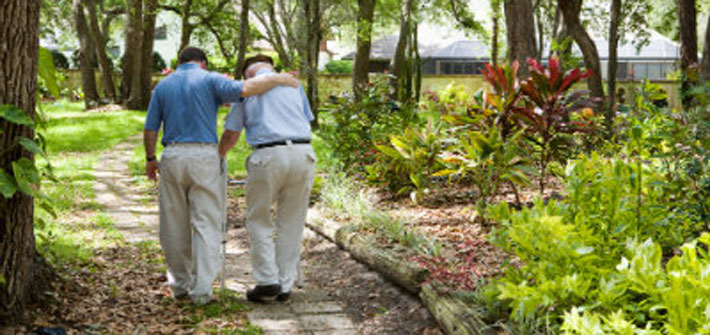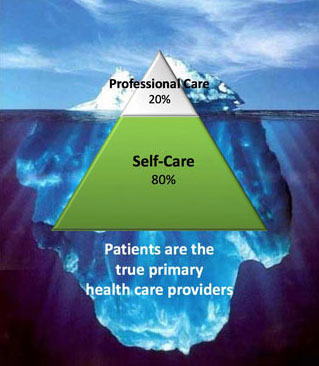
Who Provides Care?
While we tend to think of medical professionals as the providers of health care, in reality the vast majority of all care is provided by people for themselves and their families. Increasing our competence for and confidence in self-care may well be the most important function of any healthcare system.

When the healthcare system is described, patients are often viewed primarily as passive consumers of health care and health professionals as active providers of services to improve health. The usual image of the healthcare system is a pyramid with specialists (e.g., surgeons, oncologists, radiologists, etc.) at the top and primary care (e.g., family practice, internal medicine, pediatrics, etc.) at the bottom. This incomplete image of the healthcare system is, in reality, only the segment for professional care. Professional care is just the tip of an iceberg with the much larger system of lay health care or self-care submerged beneath the surface and hidden from view.
Consider the fact that, in any month, 75% of the general population experiences some kind of physical discomfort or symptom. Between 70% and 90% of these symptoms are self-diagnosed and self-managed without the help of health professionals. If only 10% of these individuals were to forgo self-care and seek professional care, the demand for costly medical care would increase by nearly 50%, immediately swamping the healthcare system.
The bottom line: The true primary healthcare providers are not doctors or nurses. Rather, the vast majority of all health care is provided by people for themselves and their families.
At the same time, it is estimated that at least 25% of physician office visits are for problems that patients could treat themselves. If self-care increased by even a small percentage of this amount, such as 5%, the demand for expensive professional services could be reduced by nearly 25%. This suggests that it may be possible to improve health while reducing healthcare costs simply by helping patients to care for themselves, i.e., knowing when to seek professional advice and when and how to use self-care.
The bottom line: The true primary healthcare providers are not doctors or nurses. Rather, the vast majority of all health care is provided by people for themselves and their families.
Once consumers are viewed in their role as providers of care, practical and safe methods of self-care could be developed and disseminated. A vital function of the healthcare system then becomes increasing self-care competence and empowering patients to become active partners in health care.
Many developing as well as developed countries are harnessing the power of lay people as providers of care. People are being trained to be health workers and health coaches to assist others in the communities with self-care, healthy lifestyle changes, and showing how to effectively access professional medical and social services when needed and appropriate. Increasingly, lay people are informally and formally providing health care with good health and economic results.
Where There Is No Doctor
Throughout the world, millions of people lack access to quality professional medical care due to geographic, economic and cultural barriers. These people can often be helped to make better self-care decisions by village health workers equipped with carefully selected and curated health information. One group providing such resources is the Hesperian Foundation, a nonprofit organization offering over 20 health guides, spanning women’s health, children, disabilities, dentistry, health education, HIV, and environmental health. Available in more than 85 languages with scores of clear illustrations, these materials are used in 221 countries and territories, from Afghanistan to Zimbabwe. Hesperian health guides are used by community health workers, Peace Corps volunteers, missionaries, teachers, health educators and community organizers to improve health around the world. Hundreds of government agencies and nonprofit organizations rely on these guides to provide practical and comprehensive information that moves communities to take action on a wide range of health issues—from disability rights to women’s health, from protecting local ecosystems to training the next generation of health workers.
Self-Care Credo
- Health care is not only everyone’s right, but everyone’s responsibility.
- Informed self-care should be the main goal of any health program or activity.
- Ordinary people provided with clear, simple information can prevent and treat most common health problems in their own homes—earlier, cheaper, and often better than can doctors.
- Medical knowledge should not be the guarded secret of a select few, but should be freely shared by everyone.
- People with little formal education can be trusted as much as those with a lot. And they are just as smart.
- Basic health care should not be delivered, but encouraged.
[From Where There Is No Doctor: A Village Healthcare Handbook, David Werner and Carol Thuman]
Lay Health Advisors and Community Health Workers
Even where there are doctors and other professional resources, lay people can help advance community health. From barbers to bartenders, farmers to shopkeepers, teachers to ministers, every community has its natural helpers—people who are sought out for health or medical advice. In some cases, these people may be more formally trained and utilized as community health workers. In China they are “barefoot doctors”; in Hispanic/Latinx communities they are called “promotores.” While most of their work entails educating target audiences about health issues affecting their community, they also provide guidance in accessing community resources associated with health care. Often community health workers are residents and identified leaders in their community who work for community-based health promotion projects or as part of a research group. Thus, the lay health advisors serve as liaisons between their community, health professionals, human and social service organizations. As liaisons, they often play the roles of an advocate, educator, mentor, outreach worker, role model, and interpreter.
Although they are not professional health workers, they are often tasked with projects similar to that of a professional health worker if the area where they work is significantly underserved (e.g., case management, referral source). Another highlight of the importance of lay health advisors is labor costs. Even though they are not required and, in most instances, do not hold academic credentials (e.g., bachelor or master’s level degrees), they perform well enough, in general, to have similar improved outcomes to that of professional health workers but while working as volunteers or at a lower salary rate.
